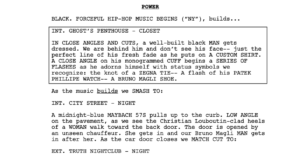The example below shows the minimum requirements to introduce a character in your script:

Name in ALL CAPS, age in parenthesis, short physical description, and an action that teaches us about his/her personality. After reading, we might think: Wow, he’s such a great, do-it-all dad! Or: WHY TF DOES HE HAVE A BABY NEAR POPPING GREASE?! HE DOESN’T KNOW WTF HE’S DOING?
These choices set the tone of the script. We can go with the latter and potentially make the story a comedy. Or we can go with the former and create a peaceful and lighthearted drama that’ll make the reader’s heart smile at FADE OUT.
2. Pro Examples:
We all know screenwriting is meant to be visual, but don’t be scared to take advantage and add some sauce and insight to who the character is. Let’s look at some professional examples to see how they engage the reader with their intros.
Below is an example from GET OUT:

We can fully visualize this introduction of CHRIS. We see him scrunching his face, critiquing his look. This may infer some sense of insecurity or that he’s about to go somewhere and he wants to look good/make a good impression. We also focus on his muscular build because later when we learn he’s a part of a chattel, it’ll matter that he’s physically strong.
With ROSE’s description, though we can’t see what “cool and beautiful like an old Summer Camp crush” looks like, we get a sense of her personality and understand why she is the best person to dupe unsuspecting black prey.
Another example is from POWER:

Wanna learn screenplay structure from The Professional Pen? Click here to take the leap.Want to see if your first 15 pages are headed down the right track? Submit your screenplay to The Professional Pen here.
Written by: Collin Shaw